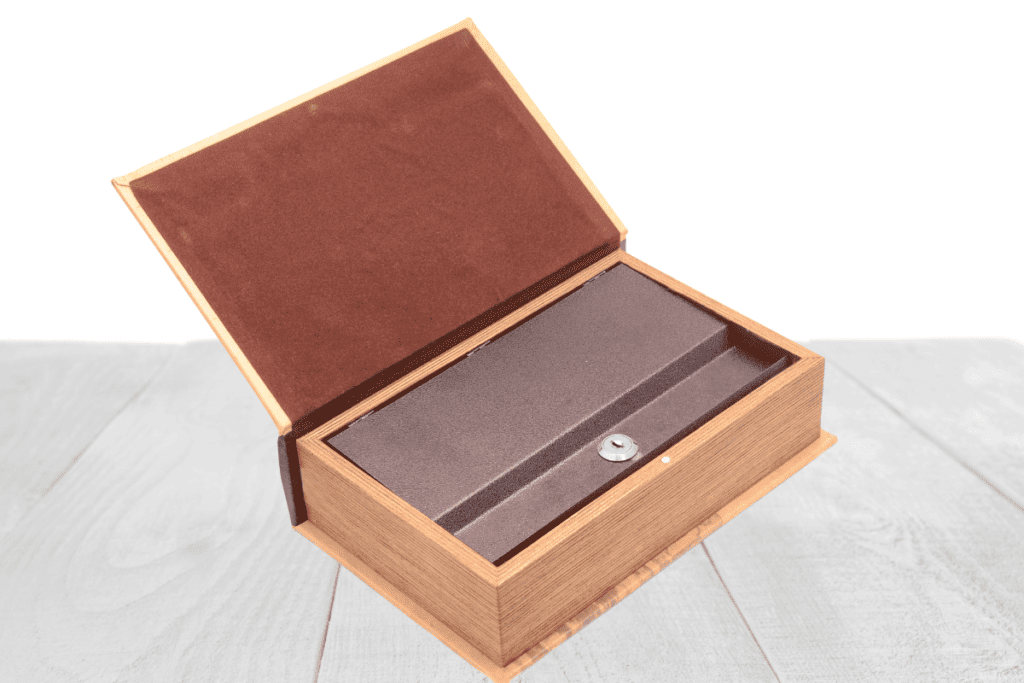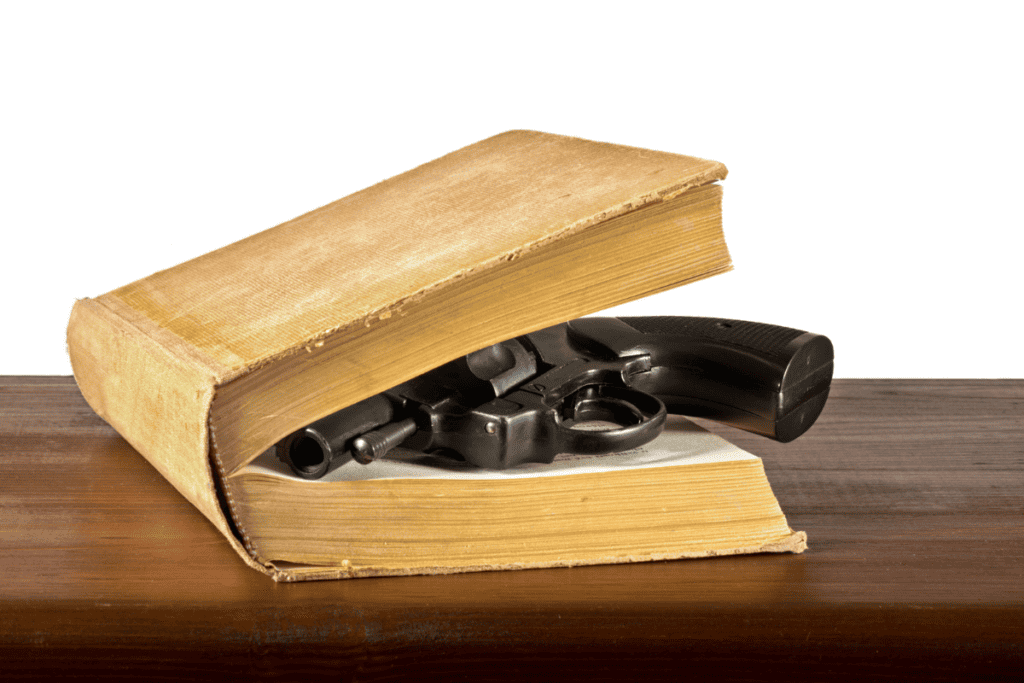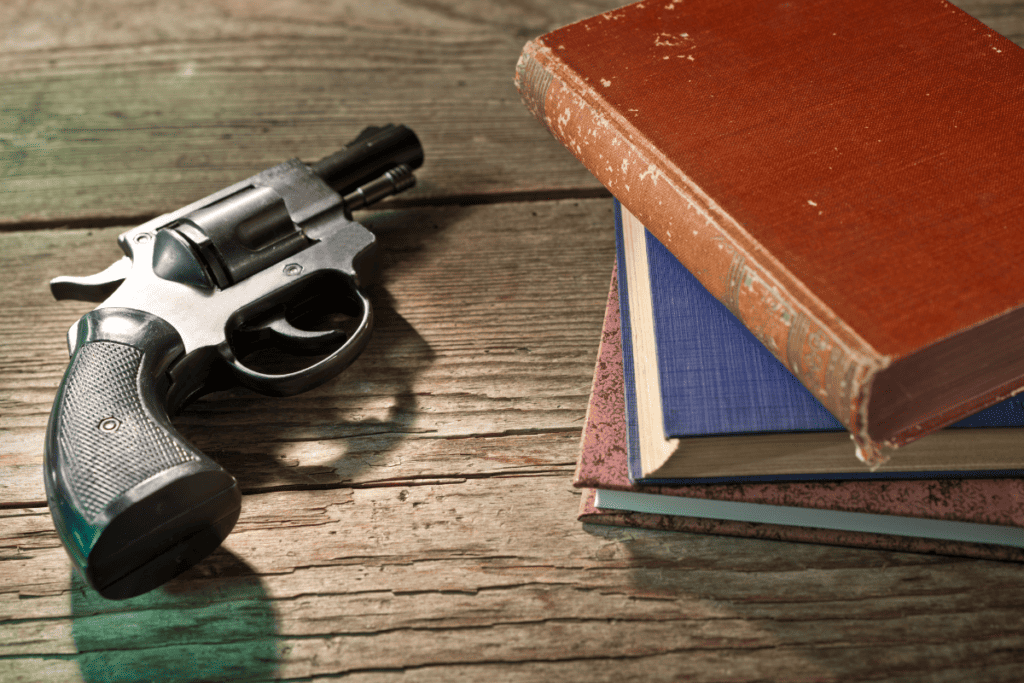Building Your Own Book Gun Safe (Safe and Concealed)

If you’re looking for a way to safely but discreetly store your gun, you’ll want to consider a secret book safe. Here’s how to make one.
A book gun safe is a good investment in adding a hidden layer of protection to your property.
Concealed gun storage is the best option for safe firearm storage. As a responsible gun owner, you must have this to prevent unauthorized persons to access your guns.
Book gun safes are the more discreet option, so you can have at least one gun close to your living areas without making it obvious.
Keep reading for what you need to know about book gun safes.
Benefits of a Book Gun Safe

We know there are several issues surrounding firearms, like unintentional firearm deaths.
According to the AAP, keeping a gun in a home where someone can easily access it increases the risk of unintentional gun injuries and intentional shootings. That is why safe storage is a priority.
Thieves also targets your gun safe and can sometimes be spotted easily if they know what to look for. A safe book gun can be hidden in plain sight if you have a bookshelf or two.
Also, making it obvious to others that you have at least one firearm isn’t the best idea. Here’s what you can look forward to with a book gun safe.
1. Space-Saving
Gun safes have the space to store several guns, plus racks for extra ammunition and other accessories. Because of this, they tend to be bulky and take up considerable space in a home.
This isn’t a problem for homeowners with lots of room. If you’re short on space, book gun safes are a good choice.
2. Customizable
There’s only so much you can do to disguise the presence of a regular gun safe. A book gun safe, on the other hand, is highly customizable. This makes it easier for you to hide it in plain sight.
3. Easy Access
While a regular gun safe is fine, it does make it difficult to arm yourself quickly if the safe is in a different room. Since you can keep a book gun safe in places you’re more likely to be, you can easily grab the book and get the gun.
4. Cost-effective
If you have just a small firearms, it won’t often make sense to get a gun safe that’s built to hold handguns and rifles. In that case, book gun safes are the best option since they’re built to hold smaller firearms.
The same can be said if you don’t have the budget for a gun vault or something similar.
A book gun safe won’t empty your wallet, but it will still provide a way to safely store a gun, a magazine, or two pieces of ammunition.
Types of Guns That Can Fit in Your Book Gun Safe
When it comes to reasons for owning firearms, many gun owners say personal protection is at the top of the list.
But even if you have a preferred firearm, it’s unreasonable to try and build a book gun safe to hold every type. That said, here are the best types of guns to consider.
1. Revolvers
Revolvers are a great choice for hiding in a book gun safe because they’re reliable. They don’t need a magazine to hold and feed ammunition into the chamber. This makes revolvers among the easiest firearms to use, too.
2. Pistols
A pistol is another type of small firearm that’s great for concealing in a book gun safe. Its small profile makes it easier to move around indoors if you know how to properly conceal carry a pistol.
In addition, pistol rounds don’t have the same penetrating power as ammunition for much larger handguns. This means you won’t have to worry about accidentally destroying possessions if a round passes through your intended target.
3. Derringers
Derringers can be even smaller than pistols, often able to hold only one or two bullets. These characteristics make them a great option for hiding in a book gun safe.
Derringers are also easy to load, reload, and shoot with no risk of the gun jamming.
4. Single-Shot Pistols
A single-shot pistol is a firearm that holds a single bullet in the chamber and must be reloaded before being fired again.
Some single-shot pistols may have a longer barrel than semi-automatics and double-action revolvers, but they’re still small enough for effective concealment.
5. Subcompact Pistol
Subcompact pistols were typically defined by their barrel length and magazine capacity, but a 9mm can hold as much as 10 rounds. So if capacity is important, you can still consider a subcompact.
Subcompact pistol barrels are usually about 3 inches long, so you’ll have no trouble concealing the gun. As you can tell, they’ll fit perfectly into even a smaller book gun safe.
How to Choose the Right Book

Choosing the right base for a book gun safe is the logical first step when making one yourself. Here are the top things to think about to make a book safe.
1. Weapon Dimensions
You can easily get the weapon dimensions you plan to keep in your book gun safe.
Focus on books a few inches wider and longer than your gun so you have enough space for protective padding or to make separate compartments.
2. Book Thickness
You don’t want to choose a book with too few pages since that may not give you enough space to conceal the gun properly. Choose one with around 300 pages, giving ample room for the safe.
3. Aesthetics
You don’t want the book gun safe to stand out. Opt for a title and cover that looks and sounds boring to keep others from pulling the book from the shelf and browsing through it.
At the same time, you’ll need a book that will blend in with the others in your library.
Please make sure you remember which book it is, though. Going through several books before finding your gun so you can arm yourself is the last thing you want to happen.
4. Cover Material
Choosing a hardcover book as the base for a book gun safe is best since the covers are sturdier. Hardcovers are less likely to warp and are more difficult to rip off, so they’ll better protect your gun.
Steps in Building Your Own Book Gun Safe

Once you’ve chosen a book, you can build your book gun safe. You will need the following tools and materials:
- Glue or Mod Podge
- Pencil
- Plastic
- Tape
- Clamps
- Utility knife
- Ruler
- Polyethylene
- Lock of your choice
- Dremel (optional)
- Semicircular Saw (optional)
- Oscillating Tool (optional)
Step 1: Choose the Starting Page for Your Compartment
Depending on how thick the book is, the compartment can start from page 50 onwards. Choose a page with an interesting illustration or photo to serve as both marker and cover for the gun compartment.
Step 2: Wrap the Covers and Extra Pages in Plastic
Take some plastic wrap or plastic bags and cover both the front and back covers and the pages covering the gun compartment. This will keep excess glue from getting on them and prevent accidental knicks from the utility knife.
Step 3: Glue the Outside Edges of the Pages Together
Using a paintbrush, spread glue on the outside edges of the pages that will serve as the gun compartment. You can add a little water to make the glue easier to spread, but not too much so that the pages will wrinkle or buckle as they dry.
You can also use Mod Podge, which acts as a glue and a sealant.
Step 4: Give the Pages Time to Dry
Close the pages and clamp them shut, then wait about a day for the glue to dry properly and the pages to harden. If you don’t have clamps, you can place something heavy on the book to keep it shut and ensure the pages stay straight.
Don’t forget to lay out some newspaper or wax paper to catch any glue that may drip down the sides of the book.
Step 5: Outline the Compartment
You must outline where they’ll go, whether you have just one compartment or several smaller ones to hold the magazine and extra bullets.
Use a ruler to ensure the edges are straight, and leave at least a 1-inch margin from the edges of the page.
Step 6: Cut the Pages
Cut and remove about 10 pages at a time using a utility knife, following your outline. Switch to a straight blade if you need extra precision at the corners. Stop cutting when you have at least 10 pages before getting to the back cover.
If you’d rather use a power tool, use an oscillating tool and semicircular blade to cut the glued-together pages, following the outline. Don’t forget to wear safety glasses and a dust mask.
You may have to stop and turn the book upside down a few times while cutting the pages. This is so you can easily shake out paper scraps and other debris.
Use this step to figure out where to place the lock on your safe, and cut out the needed space.
Step 7: Glue the Inside of the Compartment and the Back Cover
As with Step 3, use a paintbrush to spread glue or Mod Podge on the inside edges of the compartment. Use this step to glue the book’s back cover to the bottom of the compartment, too.
As before, leave the book alone to give it enough time to dry. This won’t take as long as in Step 4 since you’re dealing with less glue on a smaller surface.
Step 8: Cut the Polyethylene
Cut the polyethylene to the same size or slightly smaller than the compartment, then lay the gun on top of the foam and trace around it. Use a utility knife, or power saw to cut out the inside.
Do the same for other things you intend to keep in the book gun safe (e.g., the magazine and a box of ammunition), whether in one compartment or a separate one.
Step 9: Assemble the Book Gun Safe
You can now slip the foam into the compartment and place the gun and other items into the custom-cut spaces. Install the lock, then close the book and lock your DIY safe before slipping it onto one of the bookshelves in your home.
Safety and Usage Tips
If safe storage is one of your top priorities, then it’s logical to take some extra precautions to ensure your book gun safe is doing its job.
1. Choose a Discreet Location
You’ll need to choose a place for your book gun safe where it won’t call attention to itself.
Placing it on a bookshelf is an obvious choice, but what if you need to keep it in a room without a shelf? If so, you can place the safe on a coffee table or something similar, hopefully off to one side or in a corner where the eye won’t immediately go to it.
2. Check the Safe Regularly
You’ll want to regularly check the safe to see if you need to change the foam or take care of other maintenance tasks.
See how long it takes to unlock it, whether the keys are on your person or in a separate location but still within the room.
If you know how to pick locks, time yourself to see how long it would take for someone who doesn’t have the keys. If you feel it won’t take much time, change the lock to one that’s more secure.
3. Look into Trigger Locks
Trigger locks are another option for safe storage, and as the name implies, they ensure a gun’s trigger can’t be pulled. Depending on the type of trigger lock, you’ll need a keypad, combination, or key to unlock it.
If you can’t change the lock on your book gun safe or just want to add another layer of security, consider investing in trigger locks to keep unauthorized persons from using your firearms.
Conclusion
The materials above and the steps outlined are meant for a basic book gun safe, so if you have ideas to improve and strengthen the design, go ahead and do so. It’s your book gun safe, so it’s your decision.
Remember that you have every right to protect yourself, your family, and your property, and if the best way to do this is by owning firearms, then we’re not stopping you. But you still ought to keep responsible gun ownership in mind.
However, if you also have long guns that can’t fit a book safe, you can always rent a gun safe for temporary security.
Safe storage is part and parcel of this, and a book gun safe is the best way to combine this with discretion and ample concealment.
FAQs
Why should I build a book gun safe?
A book gun safe is a great way to conceal the fact that you have a gun in your home, which can do a lot to help you protect your family.
Is a book gun safe suitable for all types of firearms?
No, because of the size limitation. You can’t build a book gun safe for all firearms. Bigger firearms aren’t likely to fit into the average book gun safe, so you’re better off choosing smaller ones, typically those built for concealed carry.
What are the legal requirements for storing firearms in a book gun safe?
The issue isn’t the legality of storing firearms as it is their legal ownership. Gun ownership laws vary from state to state, so check with your local authorities before acquiring a gun.
Sources
“Personal Firearm Storage in the United States.” RAND Corporation, https://www.rand.org/research/gun-policy/analysis/essays/personal-firearm-storage.html.
“Safe Storage of Firearms.” Home, https://www.aap.org/en/advocacy/state-advocacy/safe-storage-of-firearms/.
Schaeffer, Katherine. “Key Facts about Americans and Guns.” Pew Research Center, Pew Research Center, 13 Sept. 2021, https://www.pewresearch.org/fact-tank/2021/09/13/key-facts-about-americans-and-guns/
Firearm Safety, https://health.ucdavis.edu/what-you-can-do/firearm-safety.html.
